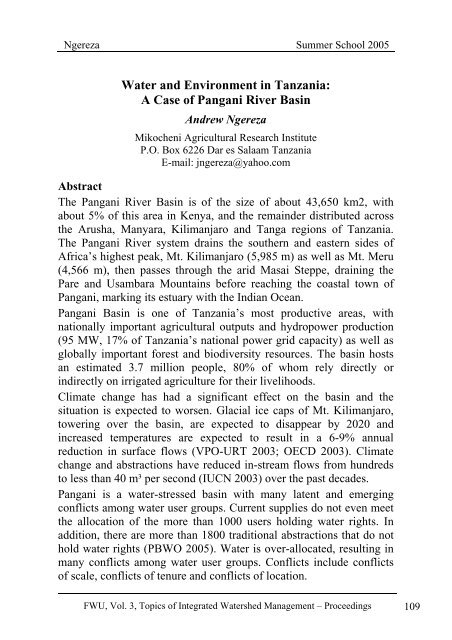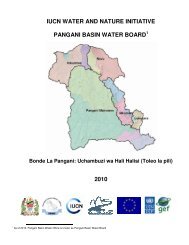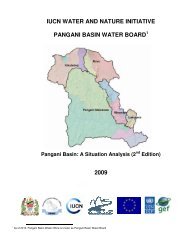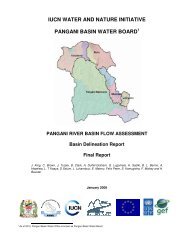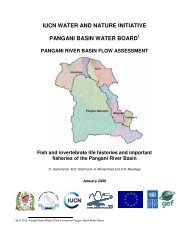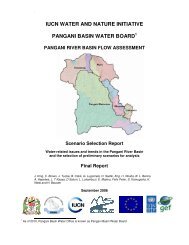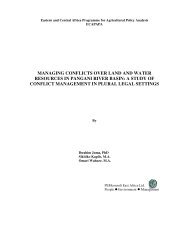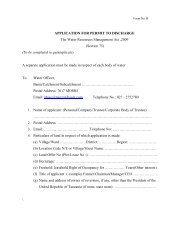Water and Environment in Tanzania: A Case of Pangani River Basin
Water and Environment in Tanzania: A Case of Pangani River Basin
Water and Environment in Tanzania: A Case of Pangani River Basin
Create successful ePaper yourself
Turn your PDF publications into a flip-book with our unique Google optimized e-Paper software.
Ngereza Summer School 2005<br />
<strong>Water</strong> <strong>and</strong> <strong>Environment</strong> <strong>in</strong> <strong>Tanzania</strong>:<br />
A <strong>Case</strong> <strong>of</strong> <strong>Pangani</strong> <strong>River</strong> Bas<strong>in</strong><br />
Andrew Ngereza<br />
Mikocheni Agricultural Research Institute<br />
P.O. Box 6226 Dar es Salaam <strong>Tanzania</strong><br />
E-mail: jngereza@yahoo.com<br />
Abstract<br />
The <strong>Pangani</strong> <strong>River</strong> Bas<strong>in</strong> is <strong>of</strong> the size <strong>of</strong> about 43,650 km2, with<br />
about 5% <strong>of</strong> this area <strong>in</strong> Kenya, <strong>and</strong> the rema<strong>in</strong>der distributed across<br />
the Arusha, Manyara, Kilimanjaro <strong>and</strong> Tanga regions <strong>of</strong> <strong>Tanzania</strong>.<br />
The <strong>Pangani</strong> <strong>River</strong> system dra<strong>in</strong>s the southern <strong>and</strong> eastern sides <strong>of</strong><br />
Africa’s highest peak, Mt. Kilimanjaro (5,985 m) as well as Mt. Meru<br />
(4,566 m), then passes through the arid Masai Steppe, dra<strong>in</strong><strong>in</strong>g the<br />
Pare <strong>and</strong> Usambara Mounta<strong>in</strong>s before reach<strong>in</strong>g the coastal town <strong>of</strong><br />
<strong>Pangani</strong>, mark<strong>in</strong>g its estuary with the Indian Ocean.<br />
<strong>Pangani</strong> Bas<strong>in</strong> is one <strong>of</strong> <strong>Tanzania</strong>’s most productive areas, with<br />
nationally important agricultural outputs <strong>and</strong> hydropower production<br />
(95 MW, 17% <strong>of</strong> <strong>Tanzania</strong>’s national power grid capacity) as well as<br />
globally important forest <strong>and</strong> biodiversity resources. The bas<strong>in</strong> hosts<br />
an estimated 3.7 million people, 80% <strong>of</strong> whom rely directly or<br />
<strong>in</strong>directly on irrigated agriculture for their livelihoods.<br />
Climate change has had a significant effect on the bas<strong>in</strong> <strong>and</strong> the<br />
situation is expected to worsen. Glacial ice caps <strong>of</strong> Mt. Kilimanjaro,<br />
tower<strong>in</strong>g over the bas<strong>in</strong>, are expected to disappear by 2020 <strong>and</strong><br />
<strong>in</strong>creased temperatures are expected to result <strong>in</strong> a 6-9% annual<br />
reduction <strong>in</strong> surface flows (VPO-URT 2003; OECD 2003). Climate<br />
change <strong>and</strong> abstractions have reduced <strong>in</strong>-stream flows from hundreds<br />
to less than 40 m³ per second (IUCN 2003) over the past decades.<br />
<strong>Pangani</strong> is a water-stressed bas<strong>in</strong> with many latent <strong>and</strong> emerg<strong>in</strong>g<br />
conflicts among water user groups. Current supplies do not even meet<br />
the allocation <strong>of</strong> the more than 1000 users hold<strong>in</strong>g water rights. In<br />
addition, there are more than 1800 traditional abstractions that do not<br />
hold water rights (PBWO 2005). <strong>Water</strong> is over-allocated, result<strong>in</strong>g <strong>in</strong><br />
many conflicts among water user groups. Conflicts <strong>in</strong>clude conflicts<br />
<strong>of</strong> scale, conflicts <strong>of</strong> tenure <strong>and</strong> conflicts <strong>of</strong> location.<br />
FWU, Vol. 3, Topics <strong>of</strong> Integrated <strong>Water</strong>shed Management – Proceed<strong>in</strong>gs 109
Summer School 2005<br />
Ngereza<br />
Introduction<br />
<strong>Water</strong> with<strong>in</strong> a bas<strong>in</strong> serves human needs such as dr<strong>in</strong>k<strong>in</strong>g, cook<strong>in</strong>g,<br />
wash<strong>in</strong>g <strong>and</strong> sanitation; allows arid l<strong>and</strong> to become productive through<br />
irrigation; provides a habitat for plants, fish, <strong>and</strong> wildlife; supplies<br />
urban <strong>and</strong> <strong>in</strong>dustrial uses; generates electricity through hydropower;<br />
<strong>and</strong> supports many recreational uses. <strong>River</strong> resources around the world<br />
have been developed <strong>and</strong> managed or centuries <strong>of</strong> control volatiles<br />
supplies <strong>of</strong> water <strong>in</strong> order to meet dem<strong>and</strong>s for water quantity, quality<br />
<strong>and</strong> reliability <strong>in</strong> time <strong>and</strong> space (Loucks, 1981).<br />
<strong>River</strong> bas<strong>in</strong>s are typically large, cross<strong>in</strong>g not only private property<br />
l<strong>in</strong>es, but regional <strong>and</strong> <strong>in</strong>ternational boundaries as well. Localized<br />
development <strong>of</strong> water resources to meet community <strong>and</strong> regional<br />
needs for clean water <strong>and</strong> food <strong>and</strong> has <strong>of</strong>ten come without regard to<br />
other users or uses. Thus, comprehensive plans to develop <strong>and</strong> manage<br />
bas<strong>in</strong> resources have been the exception rather than the rule. Private<br />
agendas, contradictory objectives, <strong>and</strong> histories <strong>of</strong> no cooperation<br />
<strong>in</strong>crease the difficulty <strong>of</strong> achiev<strong>in</strong>g efficient resource management.<br />
High <strong>in</strong>formation costs due to the many users <strong>of</strong> river bas<strong>in</strong> have<br />
impeded the process <strong>of</strong> negotiation <strong>and</strong> exchange that could lead to a<br />
socially optimal allocation. Consequently, conflicts over the<br />
developmental <strong>and</strong> allocation <strong>of</strong> water persist.<br />
The dom<strong>in</strong>ant use-conflicts over river bas<strong>in</strong> resource allocation are the<br />
water quantity <strong>and</strong> water quality <strong>in</strong> space <strong>and</strong> time. Uses may be<br />
classified as either consumptive or non consumptive. Consumptive<br />
use is def<strong>in</strong>ed to be the amount <strong>of</strong> water withdrawn from the system <strong>in</strong><br />
such a way that it is no longer available for other uses or users. In this<br />
respect, river bas<strong>in</strong> water has common pool characteristics <strong>in</strong> that one<br />
use precludes other uses. Examples are agricultural irrigation <strong>and</strong><br />
urban water use. Consumptive uses may compete by sector (e.g.<br />
municipal, agricultural, <strong>and</strong> <strong>in</strong>dustrial commercial), with<strong>in</strong> sectors<br />
(allocation to one farm versus another farm), or regionally (upstream<br />
regions versus downstream regions). Non consumptive uses do not<br />
result <strong>in</strong> a significant reduction <strong>in</strong> net stream flow, <strong>and</strong> depend<strong>in</strong>g on<br />
the type, may allow for multiple non conflict<strong>in</strong>g uses at the same time<br />
<strong>and</strong> location.<br />
110 FWU, Vol. 3, Topics <strong>of</strong> Integrated <strong>Water</strong>shed Management – Proceed<strong>in</strong>gs
Ngereza Summer School 2005<br />
Dialogues<br />
Dialogue processes require time <strong>and</strong> resources <strong>and</strong> they <strong>in</strong>crease the<br />
transaction costs <strong>of</strong> water management. At the same time, they can<br />
strengthen <strong>Water</strong> Users Associations, foster relationships between the<br />
government <strong>and</strong> communities, <strong>and</strong> promote the formation <strong>of</strong> <strong>Water</strong><br />
Users Associations where they did not yet exist. Dialogue processes<br />
have a better chance <strong>of</strong> success, if they are <strong>in</strong>itiated prior to a crisis<br />
situation. The process should <strong>in</strong>clude: an analysis <strong>of</strong> the conflict,<br />
relationship <strong>and</strong> trust build<strong>in</strong>g, negotiat<strong>in</strong>g solutions <strong>and</strong> action plans<br />
<strong>and</strong> jo<strong>in</strong>t implementation <strong>of</strong> the action plans. The more <strong>in</strong>clusive the<br />
process is the more susta<strong>in</strong>able <strong>and</strong> equitable the outcome will be.<br />
Conflicts<br />
Conflicts have emerged between water users <strong>of</strong> different sizes <strong>and</strong><br />
power <strong>in</strong> the bas<strong>in</strong>. Large scale plantations, <strong>of</strong>ten backed by foreign<br />
<strong>in</strong>vestment <strong>and</strong> us<strong>in</strong>g hundreds <strong>of</strong> litres <strong>of</strong> water per second through<br />
efficient drip irrigation systems, differ starkly from small-scale users<br />
<strong>of</strong> traditional furrow systems with efficiency as low as 14%. Similarly,<br />
the three urban centres <strong>in</strong> the bas<strong>in</strong> require more water as they exp<strong>and</strong>,<br />
pitt<strong>in</strong>g city municipalities aga<strong>in</strong>st the village governments <strong>of</strong> farm<strong>in</strong>g<br />
communities.<br />
L<strong>and</strong> Tenure<br />
Tenure is the right to manage a resource. Many small-scale users <strong>in</strong><br />
the <strong>Pangani</strong> Bas<strong>in</strong> are reluctant to apply <strong>and</strong> pay for water rights,<br />
argu<strong>in</strong>g that water is a ‘gift from God’. These communities reject<br />
government efforts to manage water resources, even to the po<strong>in</strong>t <strong>of</strong><br />
v<strong>and</strong>aliz<strong>in</strong>g water control gates <strong>and</strong> structures.<br />
Conflicts <strong>of</strong> Location<br />
<strong>Tanzania</strong> Electric Supply Company (TANESCO) pays a royalty to the<br />
M<strong>in</strong>istry <strong>of</strong> <strong>Water</strong> & Livestock Development for 95 MW, assum<strong>in</strong>g a<br />
45m³/s flow <strong>of</strong> reduced ra<strong>in</strong>fall <strong>and</strong> upstream abstractions, flow to the<br />
hydropower <strong>in</strong>stallation is <strong>of</strong>ten as little as 15m³/s, limit<strong>in</strong>g production<br />
to as low as 32 MW <strong>and</strong> creat<strong>in</strong>g national-level conflicts as power<br />
supply to the national grid is compromised. In addition, reduced flows<br />
have led to saltwater <strong>in</strong>trusions almost 20km upstream, compromis<strong>in</strong>g<br />
agricultural activities <strong>in</strong> the lower bas<strong>in</strong> <strong>and</strong> creat<strong>in</strong>g conflicts.<br />
FWU, Vol. 3, Topics <strong>of</strong> Integrated <strong>Water</strong>shed Management – Proceed<strong>in</strong>gs 111
Summer School 2005<br />
Ngereza<br />
The <strong>Pangani</strong> Bas<strong>in</strong> <strong>Water</strong> Office (PBWO) <strong>and</strong> its Board are tasked<br />
with manag<strong>in</strong>g <strong>and</strong> allocat<strong>in</strong>g water resources <strong>in</strong> the bas<strong>in</strong> <strong>and</strong><br />
ultimately balanc<strong>in</strong>g stakeholder dem<strong>and</strong>s <strong>in</strong> light <strong>of</strong> reduc<strong>in</strong>g supply.<br />
For two years, PBWO has been work<strong>in</strong>g <strong>in</strong> partnership with the local<br />
NGO Pamoja <strong>and</strong> IUCN to address water-related conflicts.<br />
Solutions to Conflicts<br />
Some <strong>of</strong> the necessary steps to resolve these conflicts <strong>in</strong>clude:<br />
awareness ris<strong>in</strong>g about water sector reforms, IWRM, <strong>and</strong> the likely<br />
effects <strong>of</strong> climate change; <strong>and</strong> support<strong>in</strong>g the water allocation process<br />
with technical data <strong>in</strong>clud<strong>in</strong>g the environmental, economic <strong>and</strong> social<br />
costs <strong>and</strong> benefits <strong>of</strong> different allocation scenarios. These steps are<br />
underway <strong>in</strong> the <strong>Pangani</strong> Bas<strong>in</strong> <strong>in</strong> a project that is part <strong>of</strong> the IUCN<br />
<strong>Water</strong> & Nature Initiative. In the meantime project partners have been<br />
work<strong>in</strong>g on a Dialogues Process to address some <strong>of</strong> the conflicts <strong>in</strong> the<br />
bas<strong>in</strong>. This process <strong>in</strong>cluded a detailed situation analysis <strong>of</strong> conflicts at<br />
five different sites <strong>in</strong> the bas<strong>in</strong>, <strong>in</strong>clud<strong>in</strong>g conflicts <strong>of</strong> scale, tenure <strong>and</strong><br />
location. A stakeholder workshop, <strong>in</strong>clud<strong>in</strong>g representatives from<br />
communities, local <strong>and</strong> national government <strong>and</strong> technical experts,<br />
was held to discuss the situation analyses <strong>and</strong> propose a way forward<br />
for resolv<strong>in</strong>g these conflicts. Subsequently, dialogue platforms were<br />
established at each site to br<strong>in</strong>g together actors to discuss the<br />
contentious issues <strong>and</strong> work towards consensus <strong>in</strong> resolv<strong>in</strong>g them. In<br />
one case this <strong>in</strong>cluded negotiat<strong>in</strong>g an agreement for l<strong>and</strong>-use plann<strong>in</strong>g<br />
that allows pastoralists access to water supplies.<br />
Another case <strong>in</strong>volved recogniz<strong>in</strong>g the efficacy <strong>and</strong> to some extent<br />
re<strong>in</strong>stitut<strong>in</strong>g traditional systems where water was managed by<br />
hydrological boundaries <strong>and</strong> not adm<strong>in</strong>istrative boundaries, mak<strong>in</strong>g it<br />
easier to negotiate agreements between upstream <strong>and</strong> down stream<br />
users. In one case, a conflict between the Arusha Urban <strong>Water</strong> Supply<br />
<strong>and</strong> small-scale downstream users, the dialogue process has stalled<br />
because <strong>of</strong> political <strong>and</strong> national <strong>in</strong>terests. The dialogue process <strong>in</strong><br />
itself has gone far <strong>in</strong> bridg<strong>in</strong>g the gap between the <strong>Pangani</strong> Bas<strong>in</strong><br />
<strong>Water</strong> Office <strong>and</strong> the communities who did not underst<strong>and</strong> the<br />
PBWO’s role <strong>in</strong> manag<strong>in</strong>g <strong>and</strong> allocat<strong>in</strong>g the resource <strong>and</strong> thus were<br />
refus<strong>in</strong>g to apply for water rights. The dialogues process, <strong>in</strong> all cases,<br />
112 FWU, Vol. 3, Topics <strong>of</strong> Integrated <strong>Water</strong>shed Management – Proceed<strong>in</strong>gs
Ngereza Summer School 2005<br />
strengthened water user associations (WUAs). Some <strong>of</strong> the lessons<br />
learned <strong>in</strong> this phase <strong>of</strong> the dialogues process <strong>in</strong>clude:<br />
Authority<br />
Traditional governance systems had ways <strong>of</strong> deal<strong>in</strong>g with water<br />
conflicts <strong>and</strong> these traditional arrangements should be recognized <strong>and</strong><br />
accommodated by authorities as much as possible with<strong>in</strong> water sector<br />
reforms. In such cases, the role <strong>of</strong> the bas<strong>in</strong> <strong>of</strong>fice is as a technical<br />
advisor on policy, legislation <strong>and</strong> best practices rather than an<br />
enforcement agency.<br />
Devolv<strong>in</strong>g Decision-Mak<strong>in</strong>g to Lower Levels<br />
People need to have a stake (ownership) <strong>in</strong> resources as an <strong>in</strong>centive<br />
to use the resource substa<strong>in</strong>ably. Therefore issues <strong>of</strong> equity, l<strong>and</strong><br />
tenure, ownership, rights <strong>and</strong> distribution <strong>of</strong> benefits must be<br />
addressed.<br />
Role <strong>of</strong> Dialogue <strong>in</strong> Strengthen<strong>in</strong>g <strong>Water</strong> Resources Management<br />
Dialogue forums strengthen <strong>Water</strong> Users Associations (WUAs) <strong>and</strong><br />
may stimulate the formalization <strong>of</strong> WUAs <strong>and</strong>/or the formation <strong>of</strong><br />
similar associations. Demonstrations are powerful, especially the<br />
demonstration, or threat, <strong>of</strong> a well-organized neighbour with legal<br />
rights to water.<br />
Dialogue Processes<br />
Dialogue processes have a better chance <strong>of</strong> success if they are <strong>in</strong>itiated<br />
prior to a crisis situation. Steps <strong>in</strong> the process <strong>in</strong>cludes, underst<strong>and</strong><strong>in</strong>g<br />
the conflict, build<strong>in</strong>g relationships <strong>and</strong> trust, agree<strong>in</strong>g on solutions<br />
(sign<strong>in</strong>g memor<strong>and</strong>ums <strong>of</strong> underst<strong>and</strong><strong>in</strong>g with action plans) <strong>and</strong> jo<strong>in</strong>t<br />
implementation <strong>of</strong> action plans.<br />
Will<strong>in</strong>gness to Negotiate Equitable Solutions<br />
The co-existence <strong>of</strong> legal <strong>and</strong> illegal water users (Those with <strong>and</strong><br />
without water permits) h<strong>in</strong>ders the will<strong>in</strong>gness to negotiate equitable<br />
solutions. The more <strong>in</strong>clusive the process is the more susta<strong>in</strong>able <strong>and</strong><br />
equitable the outcome will likely be. Increased <strong>in</strong>clusion, however,<br />
does have higher transaction costs.<br />
FWU, Vol. 3, Topics <strong>of</strong> Integrated <strong>Water</strong>shed Management – Proceed<strong>in</strong>gs 113
Summer School 2005<br />
Ngereza<br />
Capacity <strong>and</strong> Strength <strong>of</strong> Local Institutions<br />
<strong>Water</strong> is a cross-cutt<strong>in</strong>g issue <strong>and</strong> as such, many sectors have a role to<br />
play. These <strong>in</strong>clude m<strong>in</strong>istries <strong>of</strong> water, <strong>of</strong> agriculture, <strong>of</strong> plann<strong>in</strong>g, <strong>of</strong><br />
regional <strong>and</strong> local governance, among others. Sometimes these<br />
various sectors overlap <strong>in</strong> their m<strong>and</strong>ates that causes confusion.<br />
Institutional arrangements for water management must be clarified,<br />
harmonized <strong>and</strong> publicized at all levels (national, regional, district,<br />
local).<br />
Site Specific Approach<br />
The local, site specific variables <strong>in</strong>clud<strong>in</strong>g history (colonization,<br />
chiefdoms, centralization, decentralization), current politics <strong>and</strong><br />
market forces, population demographics, <strong>and</strong> effects <strong>of</strong> climate change<br />
all come <strong>in</strong>to play over water negotiations <strong>and</strong> must be understood <strong>in</strong><br />
the dialogues process.<br />
Conclusion<br />
In the case <strong>of</strong> the <strong>Pangani</strong> Bas<strong>in</strong>, with more than 500 water users<br />
associations (WUAs) <strong>and</strong> many <strong>of</strong> these hav<strong>in</strong>g conflicts over water, it<br />
is time-consum<strong>in</strong>g <strong>and</strong> expensive to establish <strong>and</strong> foster dialogue<br />
processes at all sites. For especially important conflicts (those<br />
<strong>in</strong>volv<strong>in</strong>g significant numbers <strong>of</strong> people or resources, or violence)<br />
specific forums should be established.<br />
Other conflicts, we hope, can be treated with<strong>in</strong> the context <strong>of</strong> subcatchments<br />
forums. The <strong>Tanzania</strong>n National <strong>Water</strong> Policy (2002) <strong>and</strong><br />
<strong>Water</strong> Sector Development Strategy (<strong>in</strong> draft) make provisions for<br />
such forums. There is a plan <strong>of</strong> establish<strong>in</strong>g the first sub-catchments<br />
forum <strong>in</strong> <strong>Tanzania</strong> <strong>in</strong> the Kikuletwa Subcatchment, one <strong>of</strong> the most<br />
contentious areas <strong>in</strong> the <strong>Pangani</strong> Bas<strong>in</strong>. In prepar<strong>in</strong>g to establish the<br />
forum, they will conduct a situation analysis for the sub-catchments,<br />
convene a stakeholders meet<strong>in</strong>g to get feedback on the situation<br />
analysis <strong>and</strong> <strong>in</strong>put <strong>in</strong>to the design process for the forum, conduct<br />
tra<strong>in</strong><strong>in</strong>g <strong>and</strong> awareness-rais<strong>in</strong>g to establish a common underst<strong>and</strong><strong>in</strong>g<br />
<strong>of</strong> water policy, legislation, <strong>and</strong> IWRM pr<strong>in</strong>ciples <strong>and</strong> prepare WUAs<br />
for participation <strong>in</strong> the forum.<br />
114 FWU, Vol. 3, Topics <strong>of</strong> Integrated <strong>Water</strong>shed Management – Proceed<strong>in</strong>gs
Ngereza Summer School 2005<br />
References<br />
IUCN (2003): The <strong>Pangani</strong> <strong>River</strong> Bas<strong>in</strong>: A Situation Analysis. IUCN<br />
Eastern Africa Regional Office, Nairobi.<br />
LOUCKS, DANIEL P., JERY R. STEDINGER, AND DOUGLAS A. HAITH<br />
(1981): <strong>Water</strong> Resource Systems Plann<strong>in</strong>g <strong>and</strong> Analysis.<br />
Prentice-Hall I, nc. Englewood Cliffs, N J.<br />
OFFICE OF THE VICE PRESIDENT, THE UNITED REPUBLIC OF<br />
TANZANIA (2003): Initial National Communication under the<br />
United Nations Framework Convention on Climate Change<br />
(UNFCCC).<br />
ORGANIZATION FOR ECONOMIC COOPERATION AND DEVELOPMENT<br />
(2005): Ma<strong>in</strong>stream<strong>in</strong>g Climate Responses <strong>in</strong> Development<br />
Plann<strong>in</strong>g <strong>and</strong> Assistance <strong>Pangani</strong> Bas<strong>in</strong> <strong>Water</strong> Office.<br />
Unpublished Data.<br />
FWU, Vol. 3, Topics <strong>of</strong> Integrated <strong>Water</strong>shed Management – Proceed<strong>in</strong>gs 115


